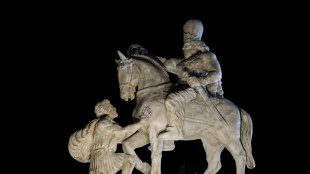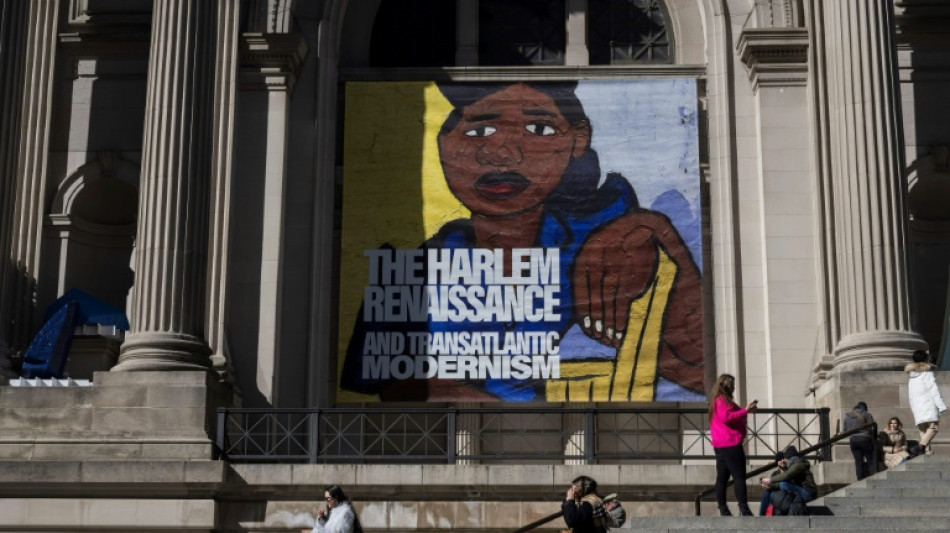
-
 Philippines evacuates hundreds of thousands as super typhoon nears
Philippines evacuates hundreds of thousands as super typhoon nears
-
Syrian president arrives in US for landmark visit

-
 Cyndi Lauper, Outkast, White Stripes among Rock Hall of Fame inductees
Cyndi Lauper, Outkast, White Stripes among Rock Hall of Fame inductees
-
Fox shines in season debut as Spurs down Pelicans, Hawks humble Lakers

-
 New Zealand edge West Indies by nine runs in tense third T20
New Zealand edge West Indies by nine runs in tense third T20
-
Messi leads Miami into MLS playoff matchup with Cincinnati

-
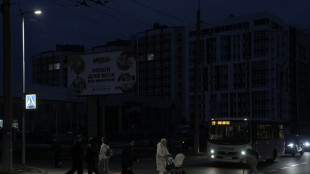 Ukraine scrambles for energy with power generation at 'zero'
Ukraine scrambles for energy with power generation at 'zero'
-
India mega-zoo in spotlight again over animal acquisitions

-
 Messi leads Miami into MLS Cup playoff matchup with Cincinnati
Messi leads Miami into MLS Cup playoff matchup with Cincinnati
-
Tornado kills six, injures 750 as it wrecks southern Brazil town

-
 Minnesota outlasts Seattle to advance in MLS Cup playoffs
Minnesota outlasts Seattle to advance in MLS Cup playoffs
-
Marseille go top in Ligue 1 as Lens thrash Monaco

-
 Fourteen-man South Africa fight back to beat France
Fourteen-man South Africa fight back to beat France
-
Atletico, Villarreal win to keep pressure on Liga giants

-
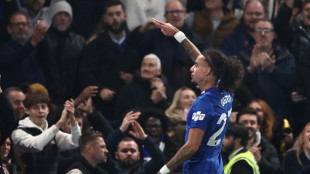 Chelsea down Wolves to ease criticism of Maresca's rotation policy
Chelsea down Wolves to ease criticism of Maresca's rotation policy
-
England's Genge eager to face All Blacks after Fiji win

-
 Wasteful Milan draw at Parma but level with Serie A leaders Napoli
Wasteful Milan draw at Parma but level with Serie A leaders Napoli
-
Fire kills six at Turkish perfume warehouse

-
 Djokovic pulls out of ATP Finals with shoulder injury
Djokovic pulls out of ATP Finals with shoulder injury
-
Rybakina outguns world No.1 Sabalenka to win WTA Finals

-
 Norris survives a slip to seize Sao Paulo pole
Norris survives a slip to seize Sao Paulo pole
-
Sunderland snap Arsenal's winning run in Premier League title twist

-
 England see off Fiji to make it nine wins in a row
England see off Fiji to make it nine wins in a row
-
Australia connection gives Italy stunning win over Wallabies

-
 Arsenal winning run ends in Sunderland draw, De Ligt rescues Man Utd
Arsenal winning run ends in Sunderland draw, De Ligt rescues Man Utd
-
Griezmann double earns Atletico battling win over Levante

-
 Title-leader Norris grabs Sao Paulo Grand Prix pole
Title-leader Norris grabs Sao Paulo Grand Prix pole
-
Djokovic edges Musetti to win 101st career title in Athens

-
 Rybakina downs world No.1 Sabalenka to win WTA Finals
Rybakina downs world No.1 Sabalenka to win WTA Finals
-
McKenzie ends Scotland dream of first win over New Zealand

-
 McKenzie stars as New Zealand inflict heartbreak upon Scotland
McKenzie stars as New Zealand inflict heartbreak upon Scotland
-
De Ligt rescues Man Utd in Spurs draw, Arsenal aim to extend lead

-
 Kane saves Bayern but record streak ends at Union
Kane saves Bayern but record streak ends at Union
-
Bolivia's new president takes over, inherits economic mess
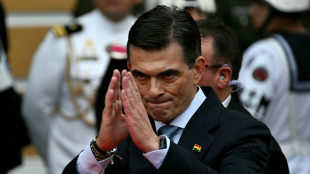
-
 Edwards set for Wolves job after Middlesbrough allow talks
Edwards set for Wolves job after Middlesbrough allow talks
-
COP30: Indigenous peoples vital to humanity's future, Brazilian minister tells AFP
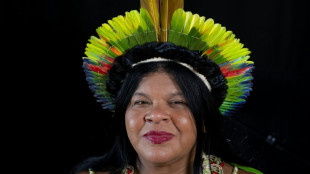
-
 Marquez wins Portuguese MotoGP sprint race
Marquez wins Portuguese MotoGP sprint race
-
Saim, Abrar star in Pakistan's ODI series win over South Africa

-
 Norris extends title lead in Sao Paulo GP sprint after Piastri spin
Norris extends title lead in Sao Paulo GP sprint after Piastri spin
-
Man Utd have room to 'grow', says Amorim after Spurs setback

-
 Tornado kills six, wrecks town in Brazil
Tornado kills six, wrecks town in Brazil
-
Norris wins Sao Paulo GP sprint, Piastri spins out

-
 Ireland scramble to scrappy win over Japan
Ireland scramble to scrappy win over Japan
-
De Ligt rescues draw for Man Utd after Tottenham turnaround

-
 Israel identifies latest hostage body, as families await five more
Israel identifies latest hostage body, as families await five more
-
England's Rai takes one-shot lead into Abu Dhabi final round

-
 Tornado kills five, injures more than 400 in Brazil
Tornado kills five, injures more than 400 in Brazil
-
UPS, FedEx ground MD-11 cargo planes after deadly crash

-
 Luis Enrique not rushing to recruit despite key PSG trio's absence
Luis Enrique not rushing to recruit despite key PSG trio's absence
-
Flick demands more Barca 'fight' amid injury crisis


Marginalized no more, expo celebrates Harlem Renaissance
The Metropolitan Museum's new Harlem Renaissance exhibit presents the Twentieth Century movement as a central force in modern art, a bold reframing that many view as long overdue.
The show, "The Harlem Renaissance and Transatlantic Modernism," which opens Sunday, is comprised of some 160 pieces depicting Black American life in the 1920s-1940s, featuring both well-known creators and some appearing in the internationally visited institution for the first time.
Spread across a dozen galleries, there are canvasses of jauntily-dressed Black couples beaming from the dance floor; graphic art-style street scenes with bright colors and forceful lines; and portraits that probe the human psyche.
The show includes a handful of works by European giants including Henri Matisse and Edvard Munch depicting dark-skinned subjects. But these canvasses play a supporting role, allowing visitors to compare contemporaneousness works on parallel subjects.
Met officials describe the show as a landmark in casting the Harlem Renaissance "as the first African American-led movement of international modern art," as Met Chief Executive Max Hollein says in the exhibit's press release.
The show marks an "opening and expanding of the art history and the narratives of art history," Hollein told AFP this week.
- Systemic problem -
While history is rife with now-canonized artists snubbed in their day, Hollein saw the downgrading of the Harlem Renaissance as categorically different, reflecting "certain systems within the cultural infrastructure that suppressed the idea of how to properly present this as a whole movement," he said.
"There are ways to change that, and this exhibition is one of them," he said.
While the Met plans to add more Harlem Renaissance works to its permanent collection, the show relied in part on loans from Historically Black universities and private collections.
At the show's media preview, Darren Walker, president of exhibition sponsor the Ford Foundation, praised those "who have preserved these works during times when what you knew was valuable, was not valued."
These include Madeline Murphy Rabb, who fought tears as she encountered "Girl With Pomegranate," a 1940 canvas by her great aunt, Laura Wheeler Waring, hanging from the Met wall.
"I have been working for decades to get my great aunt the recognition she deserves," Rabb told AFP. "My goal has always been for a broader audience to see this important work. So many whites and some Blacks have stereotypes about what they think Black artists paint about."
- Opening up -
Though commonly referenced as a cultural phenomenon, the Harlem Renaissance's contours are a bit fuzzy, both in terms of geography and duration. Painters like Archibald Motley of Chicago weren't based in New York, while the poet Langston Hughes remained a creative force through the 1960s.
Jacob Lawrence, rare among Harlem Renaissance painters in attaining major recognition during his lifetime, worked until shortly before his death in 2000.
Most accounts place the movement's inception as just after World War I, coinciding with the Great Migration that saw millions of Black Americans leave the southern United States to other US regions that were segregated but not mired in the shadows of the Ku Klux Klan and lynchings.
While this period is associated with thinkers like WEB Dubois who prioritized Black political rights, Alain Locke, a key Harlem Renaissance architect, emphasized aesthetics.
In the 1925 book "The New Negro," Locke described the potential for "the younger generation" of Blacks to lead society through "something like a spiritual emancipation" not centered on conventional political questions.
Locke urged Black painters to open themselves up to African visual tools, as well as idioms of European modernists, said Met curator Denise Murrell.
Key figures following this course included William H. Johnson, who migrated to New York from South Carolina and lived extensively in France and Scandinavia.
Johnson's works in the show have a flattened composition, semi-geometric figures and a limited palette of powerful colors, as in "Woman in Blue" from 1943, which is dominated by the urbane subject's ebony skin, her night blue dress and a lemon-colored background.
Johnson's works echo Matisse and German expressionism, but didn't aim to "imitate" them, but to employ "this international visual language in representation of a very specific local culture that (Johnson) was part of here in New York City," Murrell said.
Johnson contrasts with Waring, who also studied in Paris, but employed a more realistic style with liberal brushstroke and some other modernizing touches.
The Met is learning to be "less dogmatic in terms of what modern art can include," Murrell said before "Girl With Pomegranate," which graces the cover of the exhibition catalogue.
Waring's "subject matter was modern," Murrell said. "It was a representation of a modern Black subject that's not been a part of art history, had been ignored, or marginalized."
B.Khalifa--SF-PST



